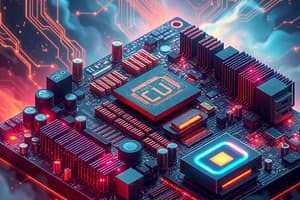Podcast
Questions and Answers
What does the CPU do?
What does the CPU do?
Process all the data and instructions that make the computer system work.
What characteristics does the power of the CPU depend on?
What characteristics does the power of the CPU depend on?
Clock speed, number of cores and cache size.
What does the CPU architecture describe?
What does the CPU architecture describe?
The main components of the CPU, their interaction with one another, and their interaction with other parts of the computer system.
What are the three main parts of the CPU?
What are the three main parts of the CPU?
What is the main job of the Control Unit (CU)?
What is the main job of the Control Unit (CU)?
What does the Control Unit (CU) control?
What does the Control Unit (CU) control?
What does the Arithmetic Logic Unit (ALU) do?
What does the Arithmetic Logic Unit (ALU) do?
What is contained within the ALU?
What is contained within the ALU?
What is the cache?
What is the cache?
What is stored in cache?
What is stored in cache?
What are the different levels of cache memory?
What are the different levels of cache memory?
What goes here? (to identify the Program Counter)
What goes here? (to identify the Program Counter)
What goes here? (to identify the Memory Address Register)
What goes here? (to identify the Memory Address Register)
What goes here? (to identify the Memory Data Register)
What goes here? (to identify the Memory Data Register)
What goes here? (to identify the Accumulator)
What goes here? (to identify the Accumulator)
What goes here? (to identify Memory)
What goes here? (to identify Memory)
What goes here? (to identify Input Device)
What goes here? (to identify Input Device)
What goes here? (to identify Output Device)
What goes here? (to identify Output Device)
What does the Program Counter do?
What does the Program Counter do?
What does the Accumulator do?
What does the Accumulator do?
What does the Memory Address Register do?
What does the Memory Address Register do?
What does the Memory Data Register do?
What does the Memory Data Register do?
What does the memory do?
What does the memory do?
Flashcards are hidden until you start studying
Study Notes
CPU Overview
- The CPU processes all data and instructions necessary for the computer system to function effectively.
- Power of the CPU is influenced by clock speed, number of cores, and cache size.
CPU Architecture
- Describes main components of the CPU and their interactions with each other and other computer parts.
Main Components of CPU
- Control Unit (CU): Executes program instructions through the fetch-decode-execute cycle.
- Arithmetic Logic Unit (ALU): Responsible for mathematical calculations, logic operations, and binary shifts.
- Cache: A type of very fast memory that is quicker than RAM but slower than registers, used to store frequently accessed data.
Control Unit Details
- CU manages data flow inside and outside the CPU.
Arithmetic Logic Unit Details
- Contains the accumulator register, which temporarily holds results from operations performed by the ALU.
Cache Memory Levels
- L1 Cache: Fastest but has the lowest capacity.
- L2 Cache: Slower than L1 but offers greater capacity.
- L3 Cache: Slowest of the cache levels but with the highest capacity.
Registers and Their Functions
- Program Counter: Holds the memory address of the instruction being executed in each cycle.
- Accumulator: Stores intermediate calculation results from the ALU.
- Memory Address Register (MAR): Holds the memory address currently being accessed by the CPU.
- Memory Data Register (MDR): Holds the data or instruction fetched from memory or awaiting storage.
- Memory: Contains program data and works in conjunction with the program counter.
- Input Device: Facilitates data input into the computer system.
- Output Device: Transfers data from the computer system to the user.
Key Functional Roles
- The cache is prioritized by the CPU for quick data access; if not found there, it checks RAM.
Studying That Suits You
Use AI to generate personalized quizzes and flashcards to suit your learning preferences.




